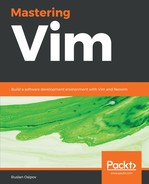Macros are stored in registers (the same ones used by yank and paste operations). You can view the contents of all your registers by executing :reg:

Close to the middle of the list you can see "a, the register containing our macro. You can also view the contents of, say, register a by executing :echo @a.
In the preceding screenshot, many special characters are represented differently. For instance, ^[ signifies the Esc key, and ^M is an Enter key.
In fact, macros are nothing but registers: the q command lets you add keystrokes to the register, while @ lets you replay the keystrokes from that register.
Since the macro is just a register, you can paste it using p. Open a new buffer with :new, and paste the contents of the register using "ap:

Now you can edit your macro without having to retype the whole thing.
When you're finished editing, copy it back into the register: _"ay$. _ will place you to the beginning of the line, "a will tell yank to use register a, and y$ will copy the text until the end of the line.
That's it. Paste the register with "ap, and place it back when you've finished editing using _"ay$.
